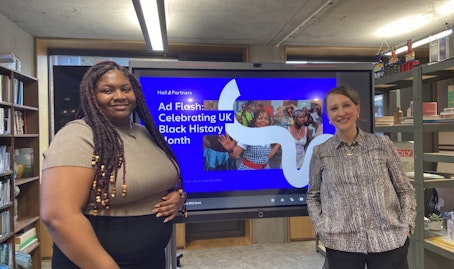Perspectives

When brands talk about inclusion, the conversation often starts and ends with representation. But representation alone doesn’t guarantee connection. Inclusion becomes meaningful when organizations build the cultural intelligence to understand the lived realities behind people’s choices—and design their strategies accordingly.
That was the core theme of a recent dialogue hosted by our Hispanic and Latin American Belonging Resource Group. The conversation explored what it takes to create authentic connection with Hispanic and Latin@ consumers and other underrepresented groups. The takeaways offer a roadmap for how any organization can see through clients’ eyes and understand cultural nuance in consumer decision-making.
Listening as strategy: How qualitative cultural research uncovers real consumer insight
Listening came up first and for good reason. Cultural intelligence research begins with informed, intentional listening: understanding the stories, contexts and constraints that shape how communities engage with a brand. That means talking not only to current customers but to non-customers, community partners and organizations that already hold trust. It means using cultural research to surface nuance—how people make decisions, who they consult and what barriers still stand in their way. Listening in this sense isn’t about politeness; it’s about learning how culture influences behavior and designing strategies around those insights.
Beyond translation: Building cultural resonance through context and connection
The conversation also challenged one of the most common missteps in cross-cultural marketing—the idea that translation equals inclusion. Many brands still assume that converting a campaign into Spanish (or any other language) is enough to reach a new audience. But language alone doesn’t build resonance. Authentic connection depends on cultural context and behavioral insight—understanding humor, family dynamics and collective values, beyond stereotypes. Within Hispanic and Latin@ communities, for example, major financial decisions are often multigenerational. Marketing or research that centers only on the individual can miss how choices are discussed and shared across families. Cultural intelligence reframes translation as a first step, not a finish line—helping brands localize meaning, not just language.
Pride as a performance driver: How genuine inclusion boosts employee and brand impact
Another key learning centered on the internal ripple effect of inclusion. When employees see their organization engaging genuinely with communities they identify with—or ally alongside—it builds pride and purpose. That pride isn’t abstract; it shows up in performance, creativity and retention, for all employees. An inclusive external strategy reinforces an inclusive internal culture, creating a feedback loop between employee engagement and customer trust.
Structural inclusion: Embedding cultural intelligence in business strategy
Finally, the conversation underscored that inclusion must be structural, not symbolic. Closing access gaps—whether in financial services, healthcare, technology or retail—requires rethinking systems, not just messaging. Partnerships with local organizations, community leaders, and educational groups can extend reach and relevance, ensuring products and services meet people where they are. Inclusion becomes most powerful when it shapes operations and policy, not only outreach.
Cultural intelligence helps organizations identify these structural gaps—translating cultural understanding into strategy, design and delivery.
From principle to performance: Turning cultural intelligence into competitive advantage
When brands make the leap from talking about inclusion to building with inclusion, they stop seeing audiences as segments and start seeing them as partners.
Cultural intelligence is what makes that leap possible. It’s how organizations learn to see through clients’ eyes—recognizing not just who people are, but how they live, decide and define value. That’s where inclusion moves from a principle to a performance advantage.
The marketplace is evolving faster than ever—and inclusion isn’t a tagline to keep up with it, it’s the engine that drives relevance, trust and growth. The brands that last will be the ones willing to embed inclusion not as a side initiative but as a core business discipline woven through their research, their teams and their products.
That’s why we built Cultural Intelligence at Escalent Group (Escalent, C Space and Hall & Partners): to help organizations turn awareness into action. Through inclusive research, immersive learning and strategic advisory, we help brands design for the world as it truly is—not the simplified version in a brief or a boardroom.
If you’re ready to evolve from intent to impact, let’s build what’s next—together.
Frequently asked questions
- How does cultural intelligence help brands connect with diverse audiences?
By using qualitative research and cultural insight, brands can identify the values, motivations and barriers that shape real consumer choices. This enables them to design more inclusive experiences, craft relevant messaging and build trust with audiences who might otherwise feel overlooked or misunderstood. - What makes cultural intelligence different from traditional market research?Traditional market research often measures what consumers do, while cultural intelligence explains why they do it. It combines behavioral science, qualitative inquiry and cultural context to help brands translate inclusion into strategy—informing product design, marketing and brand positioning that resonate deeply and authentically.
- What does understanding cultural nuance mean in consumer research?Understanding cultural nuance means recognizing the subtle social, emotional and contextual factors that influence how consumers think, decide and act within their cultural environment. In consumer research, exploring these nuances helps brands design messages, products and experiences that reflect how people truly live—not how a brief or demographic profile assumes they do.
- How does Escalent Group’s Cultural Intelligence framework help organizations act on inclusion?
Escalent Group’s Cultural Intelligence framework integrates inclusive research, behavioral insight and strategic advisory to help brands move from awareness to action. It empowers organizations to embed inclusion into their core strategy—turning cultural understanding into business growth.
Meet our authors
Kisha Payton, Chief Belonging & Inclusion Officer, Escalent Group
Ana Paula Tostado, Director, Head of LatAm, Tech & Financial Services
Talk to our team of experts
Learn how we can deliver actionable insights and creativity to drive brand growth.








